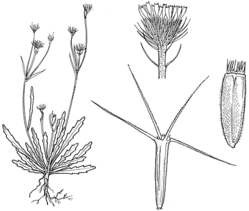Common name: Yellow Hawkweed
Tolpis barbata (L.) Gaertn. APNI* 
Description: Annual herb to c. 60 cm high; stems glabrous or cobwebby.
Leaves chiefly basal, lanceolate to linear, up to 11 cm long; lower leaves toothed to ± pinnatifid, upper leaves entire or toothed, uppermost filiform.
Inflorescence cymose, axillary peduncles overtopping terminal head; heads 4–6 mm diam.; involucral bracts green, subulate, 2- or 3-seriate. Outer florets yellow, with a purple band at the base of the ligule; central-most florets purple or brownish.
Achenes 1–2 mm long, obconic; pappus white; pappus of outer achenes c. 0.4 mm long, of inner achenes c. 3–5 mm long.
Flowering: summer.
Distribution and occurrence: Grows on roadsides and other disturbed sites in grassland, woodland and sclerophyll forest. Native to the Mediterranean region.
NSW subdivisions: *NC, *CC, *SC, *NT, *CT, *ST, *NWS, *CWS, *SWS
Other Australian states: *Qld *Vic. *S.A.
Australian collections have previously been referred to as Tolpis umbellata Bertol. All florets of T. umbellata are pale yellow, with no purple or brownish pigmentation.
Text by L. Murray, edited C. Herscovitch 5 Feb 2009 per I.R. Thompson in Muelleria 25:83-84 (2007)
Taxon concept: Flora of NSW 3 (1992), I.R. Thompson in Muelleria 25:83-84 (2007)
APNI* Provides a link to the Australian Plant Name Index (hosted by the Australian National Botanic Gardens) for comprehensive bibliographic data
***The AVH map option provides a detailed interactive Australia wide distribution map drawn from collections held by all major Australian herbaria participating in the Australian Virtual Herbarium project.
|


